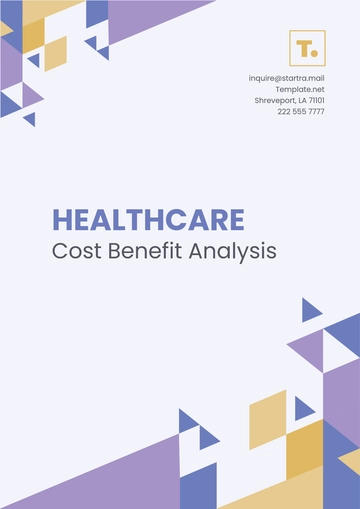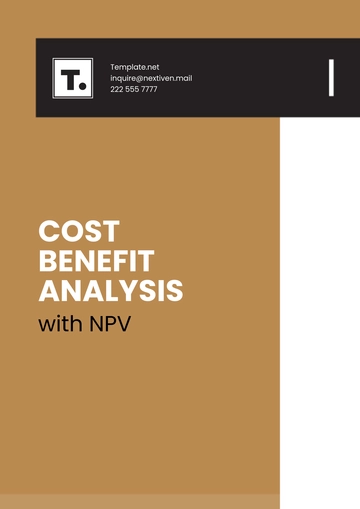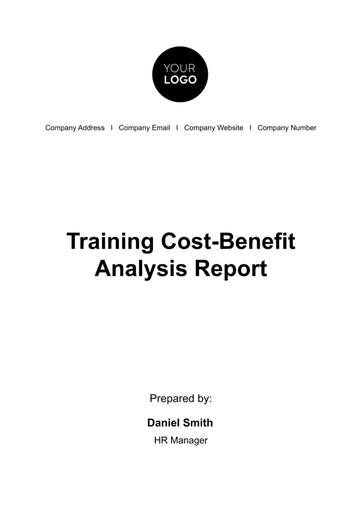Free Cafe ROI Analysis

1. Introduction
The purpose of this Return on Investment (ROI) analysis is to evaluate the financial performance and profitability of [Your Company Name] Cafe for the fiscal year 2050. This comprehensive analysis will provide insights into the efficiency and effectiveness of our operations, helping us make informed decisions for future investments and strategic planning.
2. Scope of the Analysis
The scope of this ROI analysis covers all aspects of [Your Company Name] Cafe's operations during the fiscal year 2050. This includes an in-depth examination of revenue streams, cost structures, and financial performance. The analysis aims to provide a holistic view of our cafe's profitability and the returns generated from various investments and initiatives.
Areas of Focus
Revenue Streams:
1. Coffee and Beverages Sales:
This category includes all sales from espresso-based drinks, specialty coffees, teas, and other beverages. The analysis will break down the revenue from each type of beverage, highlighting top-selling items and identifying trends in customer preferences. This data will help us understand which beverages drive the most revenue and where there might be opportunities to introduce new products or improve existing offerings.
2. Food Sales:
We will evaluate revenue generated from the sale of pastries, sandwiches, salads, and other food items. This section will analyze the popularity and profitability of each food category, providing insights into customer dining habits. Understanding the performance of our food offerings will help us make informed decisions about menu adjustments, pricing strategies, and promotional activities.
3. Merchandise Sales:
This assessment covers income from branded merchandise, coffee beans, and brewing equipment. By examining the sales data for these items, we can gauge the effectiveness of our retail strategy and identify opportunities to expand our product range or enhance our marketing efforts. Merchandise sales not only contribute to revenue but also serve as a branding tool, reinforcing our cafe's identity and presence in the market.
Cost Structures:
1. Fixed Costs:
Fixed costs are expenses that remain constant regardless of production levels or sales volume. These include rent, salaries, insurance, and other overhead costs. This analysis will provide a detailed examination of these costs, helping us understand the baseline expenses required to operate our cafe. By identifying and managing fixed costs effectively, we can improve our overall financial stability and profitability.
2. Variable Costs:
Variable costs fluctuate with the level of production and sales. These include raw materials, utilities, packaging, and other expenses directly tied to our operations. Analyzing variable costs will allow us to identify areas where we can achieve cost savings through better procurement practices, waste reduction, or process improvements. Understanding the relationship between variable costs and sales volume is crucial for optimizing our cost structure and enhancing profit margins.
Investment Analysis:
1. Capital Expenditures:
This section reviews significant investments in equipment, renovations, and technology. Capital expenditures are long-term investments that can significantly impact our cafe's operational efficiency and customer experience. By evaluating the ROI of these investments, we can determine their effectiveness and identify which types of capital expenditures yield the highest returns. This analysis will guide future investment decisions and help prioritize projects that align with our strategic goals.
2. Marketing Expenses:
Marketing expenses include spending on campaigns, promotions, and customer engagement initiatives. This analysis will evaluate the effectiveness of our marketing efforts by comparing the costs of these activities to the revenue they generate. By understanding which marketing strategies deliver the best ROI, we can allocate our budget more effectively and focus on activities that drive customer acquisition and retention. Marketing plays a critical role in building brand awareness and attracting new customers, making this analysis essential for our growth strategy.
Time Frame
This analysis covers the fiscal year from January 1, 2050, to December 31, 2050. The data and insights obtained from this period will inform our strategic planning and decision-making for the upcoming year. By focusing on a complete fiscal year, we can capture the full scope of seasonal variations, promotional impacts, and market trends that affect our business. This comprehensive approach ensures that our analysis is robust and provides a clear picture of our financial performance over time.
The scope of this ROI analysis is designed to provide a thorough understanding of [Your Company Name] Cafe's financial performance and the effectiveness of our operational and investment strategies. By examining revenue streams, cost structures, and significant investments, we aim to identify areas of strength and opportunities for improvement. The insights gained from this analysis will guide our strategic planning, helping us make informed decisions that drive profitability and sustainable growth. Through this detailed examination, we will ensure that our cafe continues to thrive and deliver exceptional value to our customers and stakeholders.
3. Objective of the Analysis
The primary objective of this ROI analysis is to measure the financial returns generated by [Your Company Name] Cafe's investments and operations during the fiscal year 2050. By evaluating the profitability and efficiency of our business activities, we aim to identify areas of strength and opportunities for improvement.
Specific Objectives
1. Measure Financial Performance:
Goal: Determine the overall profitability of the cafe by analyzing revenue, costs, and net income.
Outcome: Gain a clear understanding of our financial health and identify key drivers of profitability.
2. Assess Investment Effectiveness:
Goal: Evaluate the returns generated from significant investments in equipment, renovations, and marketing.
Outcome: Determine the effectiveness of these investments and their impact on overall profitability.
3. Identify Cost-Saving Opportunities:
Goal: Analyze cost structures to identify areas where expenses can be reduced without compromising quality or customer satisfaction.
Outcome: Develop strategies to optimize costs and improve profit margins.
4. Enhance Decision-Making:
Goal: Provide data-driven insights to inform strategic planning and future investment decisions.
Outcome: Ensure that our decisions are based on accurate and comprehensive financial analysis, leading to sustainable growth.
4. Methodology
The methodology section outlines the processes and techniques used to gather and analyze data for this ROI analysis. A systematic approach ensures that our findings are accurate, reliable, and actionable.
Data Collection
1. Financial Statements:
Sources: Income statements, balance sheets, and cash flow statements for the fiscal year 2050.
Purpose: Provide a detailed overview of revenues, costs, and overall financial performance.
2. Sales Reports:
Sources: Monthly and quarterly sales reports detailing revenue from different product categories.
Purpose: Analyze sales trends and identify top-performing products.
3. Cost Records:
Sources: Records of fixed and variable costs, including invoices, receipts, and expense reports.
Purpose: Examine cost structures and identify areas for potential savings.
4. Investment Documentation:
Sources: Records of capital expenditures and marketing expenses, including contracts and budget reports.
Purpose: Evaluate the effectiveness and returns of significant investments.
Data Analysis
1. Revenue Analysis:
Technique: Calculate total revenue and revenue breakdown by product category.
Purpose: Identify key revenue drivers and assess overall sales performance.
2. Cost Analysis:
Technique: Analyze fixed and variable costs, and calculate total costs.
Purpose: Understand cost structures and identify areas for optimization.
3. ROI Calculation:
Formula: ROI = (Net Profit / Total Investment) x 100
Purpose: Measure the financial returns generated from our investments and operations.
4. Comparative Analysis:
Technique: Compare current year data with previous years and industry benchmarks.
Purpose: Identify trends, performance improvements, and areas needing attention.
5. SWOT Analysis
The SWOT analysis provides a comprehensive overview of [Your Company Name] Cafe's internal strengths and weaknesses, as well as external opportunities and threats. This analysis helps us understand our competitive position and develop strategies to leverage strengths and mitigate weaknesses.
SWOT Matrix
Strengths | Weaknesses |
|---|---|
High-quality products | Limited menu variety |
Strong brand reputation | High operational costs |
Loyal customer base | Inconsistent service during peak hours |
Prime location | Limited seating capacity |
Effective digital marketing strategies | Dependence on seasonal sales |
Opportunities | Threats |
|---|---|
Expansion into new markets | Increasing competition |
Introduction of new product lines | Economic downturns |
Partnerships with local businesses | Rising ingredient costs |
Enhancing online sales channels | Changes in consumer preferences |
Community engagement initiatives | Regulatory changes affecting operations |
6. Revenues and Costs
A detailed analysis of revenues and costs is essential to understand [Your Company Name] Cafe's financial performance. This section provides an in-depth examination of our revenue streams, cost structures, and overall profitability for the fiscal year 2050.
Revenue Breakdown
Total Revenue: $1,500,000
Revenue by Product Category:
Product Category | Revenue | Percentage of Total Revenue |
|---|---|---|
Coffee and Beverages | $750,000 | 50% |
Food Items | $450,000 | 30% |
Merchandise | $150,000 | 10% |
Online Sales | $100,000 | 7% |
Special Events | $50,000 | 3% |
Monthly Revenue:
Month | Revenue | Percentage Change (MoM) |
|---|---|---|
January | $110,000 | - |
February | $100,000 | -9.09% |
March | $120,000 | 20.00% |
April | $130,000 | 8.33% |
May | $140,000 | 7.69% |
June | $120,000 | -14.29% |
July | $140,000 | 16.67% |
August | $130,000 | -7.14% |
September | $120,000 | -7.69% |
October | $130,000 | 8.33% |
November | $140,000 | 7.69% |
December | $220,000 | 57.14% |
Cost Breakdown
Total Costs: $1,000,000
Fixed Costs:
Cost Category | Amount | Percentage of Total Costs |
|---|---|---|
Rent | $200,000 | 20% |
Salaries | $400,000 | 40% |
Insurance | $50,000 | 5% |
Utilities | $100,000 | 10% |
Variable Costs:
Cost Category | Amount | Percentage of Total Costs |
|---|---|---|
Raw Materials | $150,000 | 15% |
Packaging | $30,000 | 3% |
Marketing and Promotions | $50,000 | 5% |
Maintenance and Repairs | $20,000 | 2% |
7. ROI Calculation
Calculating the Return on Investment (ROI) is crucial to assess the financial returns generated by [Your Company Name] Cafe's operations and investments during the fiscal year 2050. This section provides a detailed calculation of our ROI, offering insights into the efficiency of our investments.
ROI Calculation
Formula:
ROI = (Net Profit / Total Investment) x 100
Net Profit Calculation:
Metric | Amount |
|---|---|
Total Revenue | $1,500,000 |
Total Costs | $1,000,000 |
Net Profit | $500,000 |
Total Investment:
Investment Category | Amount |
|---|---|
Equipment | $150,000 |
Renovations | $200,000 |
Marketing | $50,000 |
Total Investment | $400,000 |
ROI Calculation:
ROI = ($500,000 / $400,000) x 100
ROI = 125%
8. Recommendations
Based on our ROI analysis, we have identified several strategic recommendations to enhance [Your Company Name] Cafe's profitability and operational efficiency. Implementing these recommendations will help us achieve sustainable growth and improve our financial performance.
Strategic Recommendations
1. Expand Online Sales Channels:
Rationale: With significant growth in online sales, further expanding our online presence can drive additional revenue.
Action Plan: Invest in a user-friendly e-commerce platform and enhance digital marketing efforts to attract more online customers.
2. Introduce New Product Lines:
Rationale: Diversifying our product offerings can attract new customer segments and increase sales.
Action Plan: Develop and launch new menu items, such as vegan and gluten-free options, and promote them through targeted marketing campaigns.
3. Optimize Cost Structures:
Rationale: Reducing operational costs without compromising quality can improve profit margins.
Action Plan: Conduct regular audits of fixed and variable costs, negotiate better terms with suppliers, and implement energy-saving measures to reduce utility expenses.
4. Enhance Customer Loyalty Programs:
Rationale: Strengthening customer loyalty can drive repeat business and increase customer lifetime value.
Action Plan: Revamp the loyalty program to offer more attractive rewards and personalized offers based on customer preferences.
5. Focus on Sustainability Initiatives:
Rationale: Promoting sustainable practices can enhance our brand image and appeal to eco-conscious consumers.
Action Plan: Implement eco-friendly packaging, source sustainable ingredients, and engage in community sustainability projects.
9. Conclusion
The ROI analysis for [Your Company Name] Cafe's fiscal year 2050 provides valuable insights into our financial performance and operational efficiency. With a robust ROI of 125%, we have demonstrated the effectiveness of our investments and strategic initiatives. However, there are still opportunities for improvement that can drive further growth and profitability.
Future Outlook
By implementing the strategic recommendations outlined in this analysis, [Your Company Name] Cafe can continue to enhance its market position, attract new customers, and achieve sustainable growth. Our commitment to quality, community engagement, and innovation will guide our efforts as we move forward into 2051 and beyond.
Prepared by:
[Your Name]
[Your Position]
[Your Company Name]
- 100% Customizable, free editor
- Access 1 Million+ Templates, photo’s & graphics
- Download or share as a template
- Click and replace photos, graphics, text, backgrounds
- Resize, crop, AI write & more
- Access advanced editor
Maximize your cafe's profitability with Template.net's Cafe ROI Analysis Template. Customize this template with our AI editor to assess the return on investment for various aspects of your cafe, from menu items to marketing campaigns. Analyze costs, revenue, and profit margins to make data-driven decisions and optimize your cafe's performance. Download now to streamline your ROI analysis and drive success with Template.net.





























